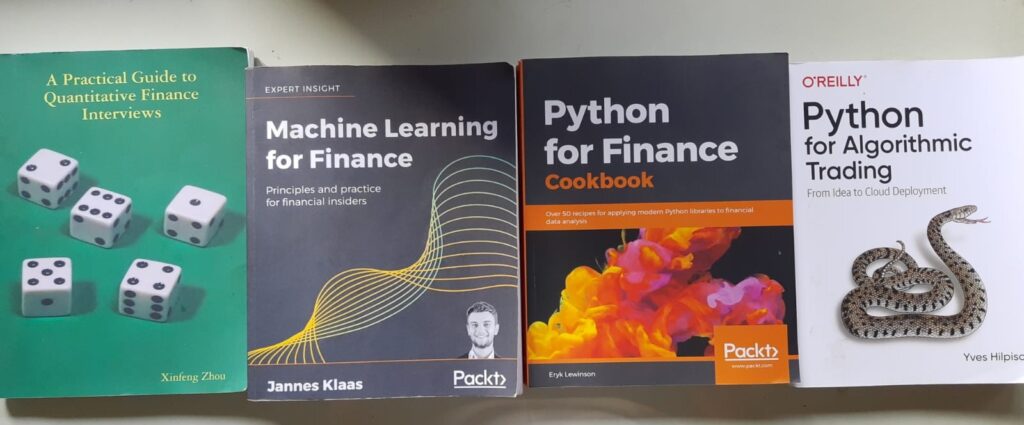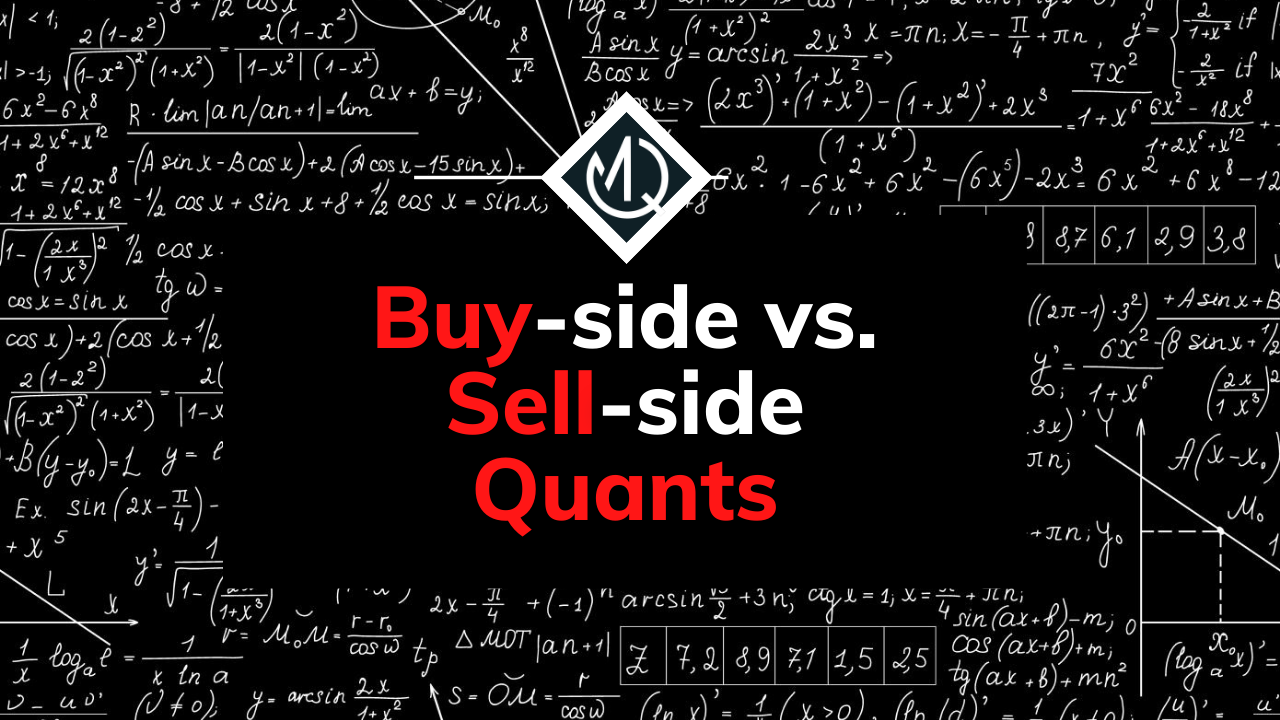When talking about financial market institutions, it is common to make an artificial distinction between buy-side and sell-side companies. Although both sides of the industry heavily rely on quantitative analysts, the roles themselves have quite a few differences. In this article, I’ll try to compare buy-side and sell-side quants and go through the main differences.
Although both buy and sell-side quants require a deep understanding of mathematics, buy-side quants specialize in statistics, whereas sell-side quants focus on Itô calculus and numerical approximations and differential equations. When it comes to compensation, both types can expect similar starting salaries ranging from $80,000 to $120,000, but certain buy-side roles do have higher upside potential.
Table of Contents
Difference between Buy vs Sell Side Quants
Broadly speaking, the sell-side is comprised of the institutions that create and sell securities to the public, whereas on the buy-side the institutions invest their resources in buying securities for trading or money management purposes. As such, both types of market participants require different types of quants.
In other words, the sell-side is mostly comprised of banks and consulting firms that create and sell securities on behalf of their clients. Common market participants that fall within the buy-side definition are pension funds, hedge funds, and proprietary firms. Sell-side institutions tend to have a strong emphasis on hierarchy, whereas buy-side shops tend to have flatter structures.
Both quant categories require extensive mathematical training, but they tend to focus on different branches. In a general sense, sell-side institutions have a bias toward the more pure, formal, or rigorous mathematic fields, favoring physicists and mathematicians. On the other hand, it is common for buy-side quants to have a background in computer science, actuarial science, electronic engineering, and, to a lesser degree, economics with a focus on mathematical modeling.
Of course, there is a non-negligible overlap between both quant categories and their distinction is more often than not also blurry. It is also very common for quants to switch from buy-side to sell-side roles and vice versa.
Although both sides have their own interesting aspects that cannot be ignored, buy-side quant roles are more attractive to professionals. In recent years, there’s been an overall trend of sell-side quants trying to switch to buy-side institutions and roles. This is not only because of higher future expected salaries but due to the overall dynamism of the sector. Hedge funds and proprietary firms are shifting from fundamental to quantitative investing, and research in systematic trading is evolving at astounding rates.
Buy-Side Quants vs Sell-Side Quants Compensation
Entry-level roles for both types of quants tend to be similar, and it is common for analysis on both sides to start with a salary of $80,000-$120,000. It is worth mentioning that the salary of more senior roles tends to favor the buy-side. Whereas there is normally a ceiling for sell-side quants, the salary of a hedge fund manager could be in the millions of dollars if bonuses are taken into account.
Buy-Side vs Sell Side Qualifications
Both types of quants tend to require highly technical and math-intensive qualifications, like physics, mathematics, actuarial sciences, engineering, and computer science, among many others.
Additionally, some positions require higher qualifications than others. While quantitative traders can “only” hold undergrad or master’s degrees, quantitative researchers are normally expected to have a Ph.D.
A Master’s degree in Financial Engineering from top programs is usually very in demand for sell-side positions. Due to the increased interest in buy-side positions, some universities are updating their Financial Engineering degrees, incorporating more subjects related to econometrics, time-series analysis, programming, and machine learning.
In short, sell-side quants are comfortable with stochastic processes (Itô calculus) and partial differential equations, and buy-side quants heavily rely on more empirical branches of mathematics, like machine learning and statistics.
Math Required for Buy-Side and Sell-Side Quants

At the risk of sounding redundant and stating the obvious, mathematical knowledge is essential when it comes to quantitative finance. Unlike other fields where basic arithmetics is part of everyday life, like accounting roles, for example, quant positions require deep knowledge of advanced mathematical topics. Almost all quants have, at the bare minimum, an undergrad degree in a STEM field.
Buy-side quantitative roles tend to focus more on data science-related topics, and a deep understanding of statistical concepts is essential in order to test whether or not trading signals are statistically significant. Additionally, depending on the specialization of the quant, heavy use of econometric models, time-series analysis and big-data analysis can be required. For lower frequency strategies, quant developers are required to make heavy use of computer science theory to reduce latency as much as possible.
Sell-Side quant roles tend to heavily rely on the topics covered in Financial Engineering degrees, such as stochastic processes, partial differential equations, ordinary differential equations, numerical approximations of definite integrals, and Taylor series expansions, among other related topics.
Both types of roles are very broad and dynamic positions, with lots of requirements for specialization. Quant researchers obviously focus on different topics than Quant Developers, but most practitioners would agree that the above description is a fair approximation of most positions.
In short, and at the risk of oversimplifying a complex question, these are the broad mathematical topics that buy-side and sell-side quants tend to gravitate to:
Math topics for buy-side quants
- Linear algebra
- Differential Calculus
- Probability and Discrete Mathematics
- Time-Series Analysis
- Machine Learning
Math topics for sell-side quants
- Ordinary Differential Equations (ODE)
- Partial Differential Equations (PDE)
- Numerical Approximations of Definite Integrals
- Montecarlo Simulations
I cannot overstate how much of an oversimplification the above lists are. As should be expected, these topics are by no means mutually exclusive between both types of quants.
Buy-Side vs Sell Side Working Hours
Both buy and sell-side quant positions are universally famous for having long working hours when compared to other jobs. Having said that, sell-side quantitative positions tend to feature more volatile working hours. Sell-side positions also have a higher probability of requiring long hours during the weekends, something that is less so for buy-side positions (especially for quantitative traders).
Buy-Side Quants
In the most basic sense, the duties of buy-side institutions revolve around increasing the value of the portfolio and having more assets under management (AUM).
Buy-Side Quants tend to focus their time researching, developing, and implementing trading strategies. Of course, as is also the case for Sell-Side Quants, risk management and reporting are part of the daily routine of a subgroup of these quants.
These quants tend to have a general knowledge of data science, econometrics, time-series modeling, and machine learning. Additionally, depending on the type of trading developed, they are usually proficient in Python, Java, C++, or C (ordered from low to high-frequency trading).
Contrary to sell-side quants, it is usually preferred to have expertise in Statistics or Computer Science instead of traditional financial engineering.
It would be too simplistic to assume that all roles within buy-side shops were the same. This of course also applies to sell-side quantitative positions. In order to dig a little deeper into each one of these, I’ll try to group most positions into a few subcategories. This list is by no means exhaustive, but nonetheless gives a broad idea of the day-to-day responsibilities of most quants working in the industry.
Quant Traders

Despite their name, quant traders don’t manually enter buy and sell orders. This position usually is in charge of responding to specific market dynamics during and adjusting the volatility curves of the shop’s portfolio.
Depending on the specifics of the role, quantitative traders are usually comfortable in a higher-level programming language like Python in order to perform data science tasks on the fly during market hours. Also, depending on the size of the firms and the roles themselves, these roles range from being mostly trading related to being research-intensive.
Quantitative traders typically hold undergrad or master’s degrees in quantitative-oriented fields. The interviews for these positions usually focus on probability brainteasers, and math questions with the purpose of evaluating how the candidate reacts under pressure and how fast he can perform mental calculations.
As with all quantitative positions, quantitative traders can expect to earn high salaries, with great upside potential due to the high correlation between bonuses and their performance.
Quant Researchers
Quantitative researchers are the ones in charge of researching and coming up with the strategies that will create the signals that might eventually be used in live trading.
Unlike quantitative traders, these roles do not depend on market hours, since they mostly deal with historical data in order to develop models that are likely to yield above-market risk-adjusted returns.
Due to the nature of their responsibilities, quant researchers tend to have the most impact on the performance of quantitative hedge funds or proprietary firms. As a consequence, quantitative researchers also tend to have very attractive salaries with large upside.
Although they have more job stability than quantitative traders, these positions are still less secure when compared to quant developers.
It is most likely for these positions to be filled by PhDs from math-intensive fields. Interviews tend to cover a broad range of topics, from statistical modeling to probability brainteasers and coding challenges.
Quant Developers
The daily duties of quant developers are oftentimes the same ones of regular software developers, although some roles require an understanding of the research of quant developers in order to translate it into highly performant code.
Depending on the type of shop they work for, their responsibilities range from developing low-latency algorithms in C++ (or even C) and implementing algorithms that optimize order fulfillment by reducing slippage, to creating tools for quantitative traders and implementing trading strategies created by quantitative researchers.
Whereas low latency tasks and high-frequency trading algorithms require low-level programming languages such as C++ and C, mid to low-frequency algorithms are usually implemented in high-level programming languages such as Java and Python.
Although quant developers can also expect to receive generous compensation, the upside potential is usually smaller when compared to other quantitative roles.
Sell-Side Quants
Sell-Side Quants create tailor-made securities and hedge complex portfolios for their clients. The math required for these types of positions usually is the one to be found in the curriculum of a Masters’s in Financial Engineering. These programs cover Ordinary Differential Equations, Partial Differential Equations, Stochastic Calculus, and continuous-time modeling.
Due to the nature of sell-side institutions, some roles require to be client-facing and thus focus on creating relationships and attracting new clients.



2 Responses
Excellent summary! I
Thanks! I’m glad you liked it!